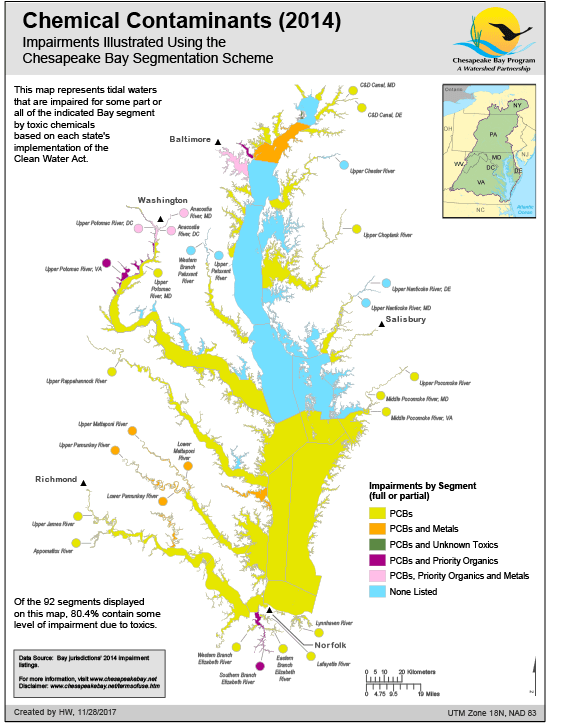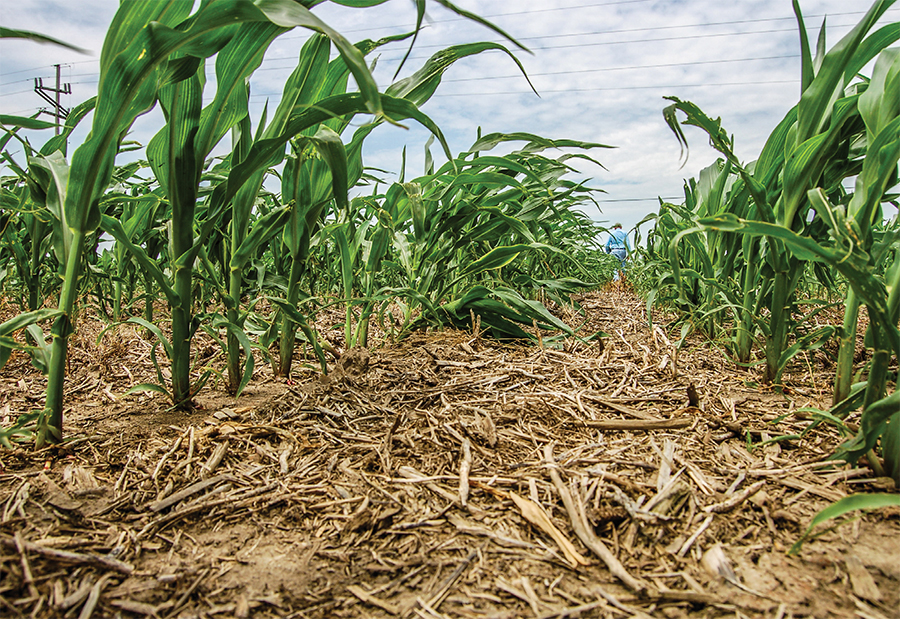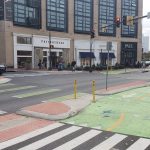Pesticides in Our Waterways: The Ins and Outs
By Daniel Hirsch, 2022-2023 Environmental Leader
Nowadays, it is very rare to see a farm that does not make use of pesticides in one way or another, and our environment is paying for it. Currently, over 84% of the Chesapeake Bay is partially or fully impaired by chemical contaminants (Chesapeake Bay Program). This has caused irreversible damage to the ecosystems connected to the Chesapeake and even put Maryland’s human population at risk of consuming toxic chemicals along with their locally caught seafood. Agricultural pesticide use is a leading contributor to this contamination.

Why is this contamination so detrimental? Once chemicals enter an ecosystem’s cycle, it makes its way through the food chain, impacting all the organisms along the way. As the toxins make their way up the food chain, they become more concentrated and more harmful to the organisms impacted by them, this is called biomagnification. This means that the high levels of chemical contamination in the Chesapeake are not only hurting aquatic species, but also birds, land animals like deer, and even humans.
There are many ways to reduce pesticide contamination from farms but due to the inconvenience, most large agriculture companies stray from practicing these techniques. Though there is still a long way to go, agricultural sustainability levels across the country are on the rise thanks to the following systems:
Crop rotation and Intercropping – Intercropping is the process of growing multiple species of crops in the same area. Reduces the need for pest control by disrupting the concentration of host plants and lowering the possibility for infestations. Crop rotation is the cycling of new crops throughout the seasons. It improves soil health by providing nutrients to maintain soil fertility, and introducing more biodiversity which is crucial to a thriving farm (with healthier soil comes less runoff). Crop rotation also interrupts pest and disease cycles, reducing the need for pesticides.

No-till farming – Planting crops without disturbing the soil through tillage. While tilling has its benefits, it causes erosion and is harmful for the soil’s fertility. No-till farming on the other hand preserves organic matter and sturdies the structure of the topsoil, boosting its fertility and making it resistant to erosion and runoff. It also enables the use of other techniques such as cover cropping as the land surrounding the crops remains untouched and healthy. Not to mention it saves the farmer time and money by eliminating the process of tilling and the expenses surrounding it.
Cover cropping – Planting cover crops year-round on what would usually be open soil. Cover cropping is very beneficial as it ensures that there are living roots in the ground at all times, reducing erosion, increasing the nutrients that the soil receives and reducing weeds. Despite the hassle it bears, this technique limits runoff and eliminates the need for herbicides and fertilizers.

Integrated livestock (My personal favorite) – Carefully introducing certain species of livestock that will benefit the crops by eliminating pests and improve soil quality through manure which also works as a substitute for fertilizers. Though this requires more attention from farmers, making it less efficient, it is very sustainable and cost effective. An example of this is allowing ducks to graze among crops with an infestation of bugs, this would eliminate the need for pesticides as the bugs are no longer an issue, and it would provide the ducks a source of nutrition.
Progress that has been made
The future is bright! Since 2014, total usage of pesticide products has been reduced by 58% in Maryland (MD Department of Agriculture). In February of 2018, the Maryland Department of Agriculture announced a regulatory phaseout of the pesticide chlorpyrifos, used for treating pests but found to be harmful to young children and child-bearing women. Thankfully, this downward trend shows no signs of stopping.
Maryland’s culture is fueled by its waterways. As a coastal state; our economy, daily life and tourist attraction is centered around local aquatic ecosystems. I cannot stress enough how crucial it is that we remain on this path towards less future contamination and I urge you to play your part when possible. This entails small things like buying produce from sustainable farms, voting for candidates focused on sustainability and even chipping in at local restoration and cleanup projects.
Works Cited
Chemical contaminants. Chesapeake Bay Program. (n.d.). Retrieved November 3, 2022, from https://www.chesapeakebay.net/issues/threats-to-the-bay/chemical-contaminants
Maryland Department of Agriculture. (2022, May 5). Department of Agriculture Releases Pesticide Use Survey. The BayNet. Retrieved November 3, 2022, from https://thebaynet.com/department-of-agriculture-releases-pesticide-use-survey/
What is sustainable agriculture? Union of Concerned Scientists. (n.d.). Retrieved November 3, 2022, from https://www.ucsusa.org/resources/what-sustainable-agriculture
Emery, S. E., Anderson, P., Carlsson, G., Friberg, H., Larsson, M. C., Wallenhammar, A.-C., & Lundin, O. (1AD, January 1). The potential of intercropping for multifunctional crop protection in oilseed rape (brassica napus L.). Frontiers. Retrieved November 3, 2022, from https://www.frontiersin.org/articles/10.3389/fagro.2021.782686/full
Crop rotations. Rodale Institute. (2020, December 15). Retrieved November 3, 2022, from https://rodaleinstitute.org/why-organic/organic-farming-practices/crop-rotations/#:~:text=Crop%20rotation%20helps%20return%20nutrients,increase%20biodiversity%20on%20the%20farm
Horton, J. (2022, August 24). How no-till farming works. HowStuffWorks Science. Retrieved November 3, 2022, from https://science.howstuffworks.com/environmental/green-science/no-till-farming.htm
Image sources:
Crop Livestock Integration. Rodale Institute. (2020, September 29). Retrieved November 3, 2022, from https://rodaleinstitute.org/science/crop-livestock-integration/
Chemical contamination. Chesapeake Bay Foundation. (n.d.). Retrieved November 3, 2022, from https://www.cbf.org/about-the-bay/maps/pollution/chemical-contamination.html
Till movement in U.S. continues to grow. No. (n.d.). Retrieved November 3, 2022, from https://www.no-tillfarmer.com/articles/489-no-till-movement-in-us-continues-to-grow?v=preview
About the Author:
 Daniel Hirsch, 2022-2023 Environmental Leader
Daniel Hirsch, 2022-2023 Environmental Leader
Daniel is a Senior at Montgomery Blair High School and part of Bethesda Green’s Environmental Leaders Program. All his life he has been surrounded and inspired by nature and that has fueled his passion for the environment. He has seen first hand the difference environmental stewardship can make and would like to be a force for change. He is looking forward to working with my like minded peers to make a real difference and set our community on the path to a greener and more sustainable future. He is also an avid soccer player and enjoys cooking.





